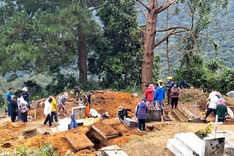Vietnam is at elevated risks from infectious diseases, given its location in the hot and humid tropical monsoon region as well as the increasing rate of trade and travel.

Changing weather conditions heighten the risk of disease transmission from circulating diseases such as dengue fever, hand-foot-and-mouth disease, measles...; vaccine-preventable diseases such as pertussis, avian flu, mumps, to newly emerging dangerous diseases imported from abroad such as monkeypox.
According to the Ministry of Health, in 2023, the world continued to record cases of illness and death from diseases transmitted from animals to humans or newly emerging dangerous infectious diseases in many countries. According to the World Health Organization (WHO), in December 2023, the world recorded nearly 10,000 deaths from COVID-19, with hospitalisations increasing by 42 per cent compared to November 2023; new variants of SARS-CoV-2 continue to evolve, with the JN.1 variant rapidly increasing globally.
In the United States, China, and some European countries, there has also been a resurgence of COVID-19 infections along with the spread of respiratory diseases such as seasonal flu and respiratory syncytial virus (RSV).
WHO estimates that annually there are about one billion cases of seasonal flu, including 3-5 million severe cases; among them, 290,000 to 650,000 prove to be fatal. In addition to seasonal flu and acute respiratory infections, in 2023, the world also recorded cases of high-pathogenic avian influenza such as A(H5N1), A(H5N6), and A(H9N2).
In 2023, Vietnam managed to have solid control over infectious disease situation, with the general goal of minimising the incidence and mortality from infectious diseases compared to the 2016-20 average.
COVID-19 has officially become a transmissible disease belonging to Class B, playing an important role in the country's economic and social recovery and development; the number of cases and deaths from dengue fever has sharply decreased compared to 2022; hand-foot-and-mouth disease and measles have seen an increase in cases compared to 2022 but have been promptly controlled, and starts to decline in numbers since October 2023.
Pertussis only occurred locally in some northern mountainous provinces, and no Class A infectious diseases such as plague, Ebola, MERS-CoV, avian flu A(H7N9), avian flu A(H5N1), and avian flu A(H5N6) were reported domestically.
However, according to the Ministry of Health, disease prevention and control still face various challenges, with unstable, unpredictable disease developments (including the emergence of new diseases, and mutations of existing ones).
Key areas for dengue fever with high annual prevalence are densely populated areas, urbanisation, many construction works, industrial parks, population dynamics with many tourists, students and ethnic minorities, making it difficult to control disease cases and implement epidemic prevention and control activities.
Vaccination rates in some areas are still low, especially in remote areas and areas inhabited by ethnic groups, so the immune response may decrease over time, the ministry warned.
Some places have not really been proactive in ensuring logistics support for epidemic prevention and control, leading to a lack of readiness in medicines, vaccines and medical supplies for the monitoring, inspection, diagnosis and treatment of infectious diseases such as dengue fever, hand-foot-and-mouth disease, pertussis and monkeypox.
Ready for epidemics
In the new plan for infectious disease prevention and control in 2024, the health ministry proposes that the People's Committees of provinces and cities direct the health departments to develop a plan for infectious disease prevention and control in 2024 to submit to the provincial and city People's Committees for approval as well as enhancing the role and responsibility of authorities at all levels in disease prevention and control.
In addition to ensuring the preparedness of response plans for epidemics, localities must consolidate and enhance the capacity of the epidemic prevention and control system at all levels, especially in remote areas, mountainous areas, border areas, islands, areas with a concentration of ethnic minorities and mobilise the participation of authorities and social-political organisations in the efforts.
Frequent epidemic surveillance is also urged, especially at border gates, community and health facilities, to detect threats and devise responses in time, in order to prevent widespread transmission and prolonged outbreaks in the community.
Local authorities direct healthcare facilities in the area to effectively carry out patient management, timely treatment, minimise severe cases, deaths, and control infections, preventing cross-infections in healthcare facilities, and ensuring drugs, biological products, supplies, chemicals and equipment to meet the requirements of epidemic prevention and control.
The health ministry also orders holding regular campaigns to eradicate mosquitoes and larva, keeping in mind the involvement of the community in the dengue-fever prevention efforts.




















